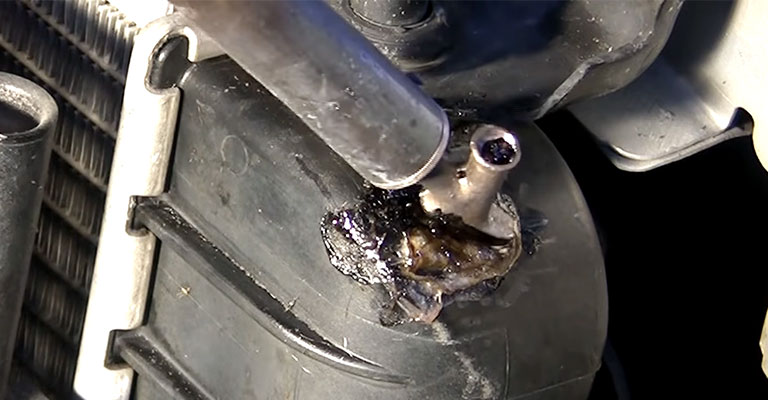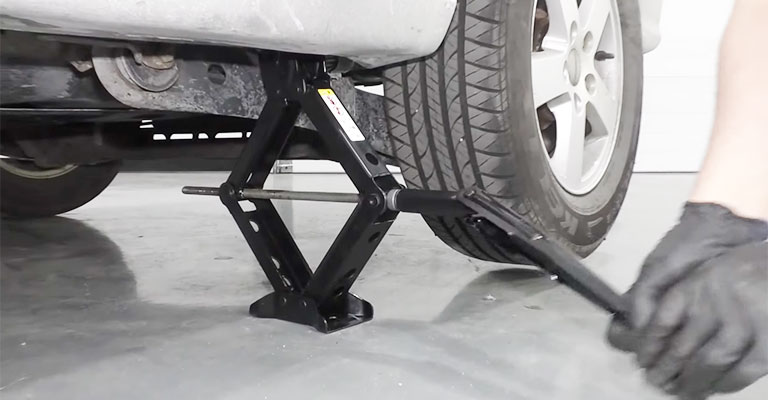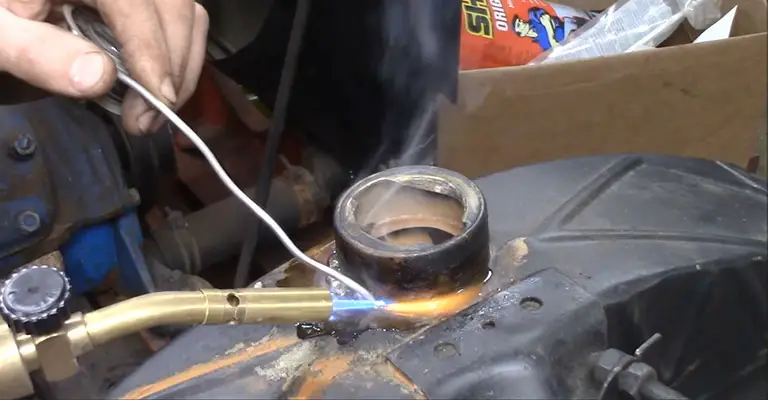Are you getting frustrated with engine overheating and coolant leaks? One of the main reasons can be a cracked radiator. It causes the coolant to leak from the radiator, thus the sufficient amount of coolant fails to reach the engine. As a result, the engine overheats.
Replacing the radiator is not always an economical option. The good news is that you can fix a cracked radiator. To know more about this, you need to dig deeper into this article.

Can You Fix a Cracked Radiator?
Fixing a cracked radiator by yourself can be intimidating. But it is not that difficult if you have proper guidance. So, here is a step-by-step guide for you.
Step 1: Cool Down the Engine
The radiator system deals with high temperatures and pressure while it is in operation. Working on a heated and pressurized radiator may cause serious burns. Therefore, your first step before getting into fixing the crack is to cool down the engine.
Turn off the engine and let it sit for some time so that the engine and its components can cool down. After a few hours, lightly touch the radiator to see if it’s still hot. Even if the temperature outside the radiator may seem tolerable to work, the coolant inside may be still very warm. Hence, it is better to wait until the radiator is completely cool.
Step 2: Drain the Radiator Coolant
Once the system is cooled down, you will need to drain the radiator. Here’s how to do it.
Step 2.1: Jack up the Vehicle

Usually, the drain plug for the radiator is located underneath the vehicle. If your vehicle is high enough to access the plug, you may not need to jack up the vehicle. But if you cannot access it properly, you will need to raise the height of the vehicle to allow yourself under it.
Locate the jack points of your vehicle. Then use the jacks to jack up your vehicle high enough so that you can work under it without facing any obstacles.
Step 2.2: Open the Radiator Drain Plug
The radiator drain plug often looks like a spout with a valve and should be around the bottom of the radiator. Put a container below the plug. Then turn the plug and let the coolant flow in the container. Be cautious while touching it with bare skin, because it may still be slightly warm.
Step 3: Fixing the Crack

There are a few different ways to fix a radiator depending on the material it is made of. Such as using radiator epoxy, soldering, or fusion welding. You can’t just pick one randomly though. The method that will deliver the best outcome depends on the type of radiator of your vehicle.
Fixing a Cracked Radiator With Radiator Epoxy
If your vehicle’s radiator is made of aluminum or plastic, using radiator epoxy is an economical solution. To fix a cracked radiator with epoxy, follow these steps:
- Clean the area of the crack and its surroundings properly with brake cleaner. Then sand the cracked area. Sanding the area will help the epoxy bond with the radiator surface well.
- Then let the cleaned area dry completely.
- Knead the epoxy using your hands to make it soft and pliable. Spread it generously throughout the area of the crack.
- Make sure to cover the whole area with epoxy. The epoxy layer needs to be stable when high temperature and pressure build up inside the radiator.
- Wait for the epoxy to set. It is better to wait overnight and allow it to be cured properly.
Fixing a Cracked Radiator by Soldering

Soldering works well to cover the cracks on a copper-brass radiator. Follow these steps to do it accurately:
- First, clean the surrounding area with a brake cleaner. If there is cracked paint or metal pieces in that area, remove them. Use a metal or steel wire brush to clean that area gently. Make sure not to do any further damage in that area.
- Wait until the area is completely dried.
- For the best outcome, try to use a heavy-duty soldering iron to solder the radiator. A low-wattage radiator may not be able to melt the radiator cracks properly.
- Heat the cracked area using the head of the soldering iron. Once the cracked area is hot enough, solder the soldering wire in that area slowly. Cover the entire cracked area properly with solder.
- When the soldering is done, take the steel wire brush again and grind the area gently, just to smoothen the sharp edges and uneven surface of the solder. Don’t grind it too hard, otherwise, you may weaken the solder.
Fixing a Cracked Radiator by Fusion Welding
Using epoxy may be an economical solution for both aluminum and plastic, fusion welding is a better one in the case of plastic radiators. In this case, a nylon-based welding rod is used. Follow the steps below to fix a cracked plastic radiator with fusion welding:
- Clean the area first with brake cleaner. Then grind the area a little bit. Allow the area to dry properly.
- Use the heat gun to pre-soften the damaged area. Though it is not necessary, it will make the repairing process faster.
- Then use a nylon-based welding rod and melt it in the cracked area. The color of the rod should turn slightly brown.
- Apply a sufficient amount of melted nylon-based rod. Then use the tip of the heat gun to mix the melted nylon and radiator plastic gently. Keep mixing until the mixture becomes a single color.
- Allow the welding to set before starting the engine.
Step 4: Examine the Fix
After you are done fixing the crack, check and reinstall everything that you have extracted. Start the vehicle and let the engine run for 10 – 30 minutes. Then check the fixed area again for leaks. If everything’s fine, your radiator is fixed properly.
FAQ
1. Can you drive with a cracked radiator?
Answer: It is unsafe to drive with a cracked radiator. Due to a crack in the radiator, coolant leaks from it. Thus, enough amount of coolant cannot reach the engine. As a result, the engine may overheat which can cause serious problems.
2. Is there a sealant for a cracked radiator?
Answer: Some commercial leak sealants can be found in the auto parts store. Sealants can come in handy while solving small cracks in the radiator. However, this is not a permanent solution. You may use a sealant to close a leak temporarily, but you still need to find and close the crack.
3. What causes a radiator to crack?
Answer: Several reasons can cause a radiator to crack. Two of the most common reasons are constant road vibrations and continuous thermal cycling over time. Other reasons include an overheating engine, faulty engine thermostat, poorly maintained coolant, hot climate, accidents, road debris, etc.
Bottom Line
If the radiator still leaks after the fixing of the cracks, there may be hidden cracks that you have missed. Besides, the crack may be a lot bigger sometimes. In these cases, it is better to replace the radiator with a new one.
Leave a Reply